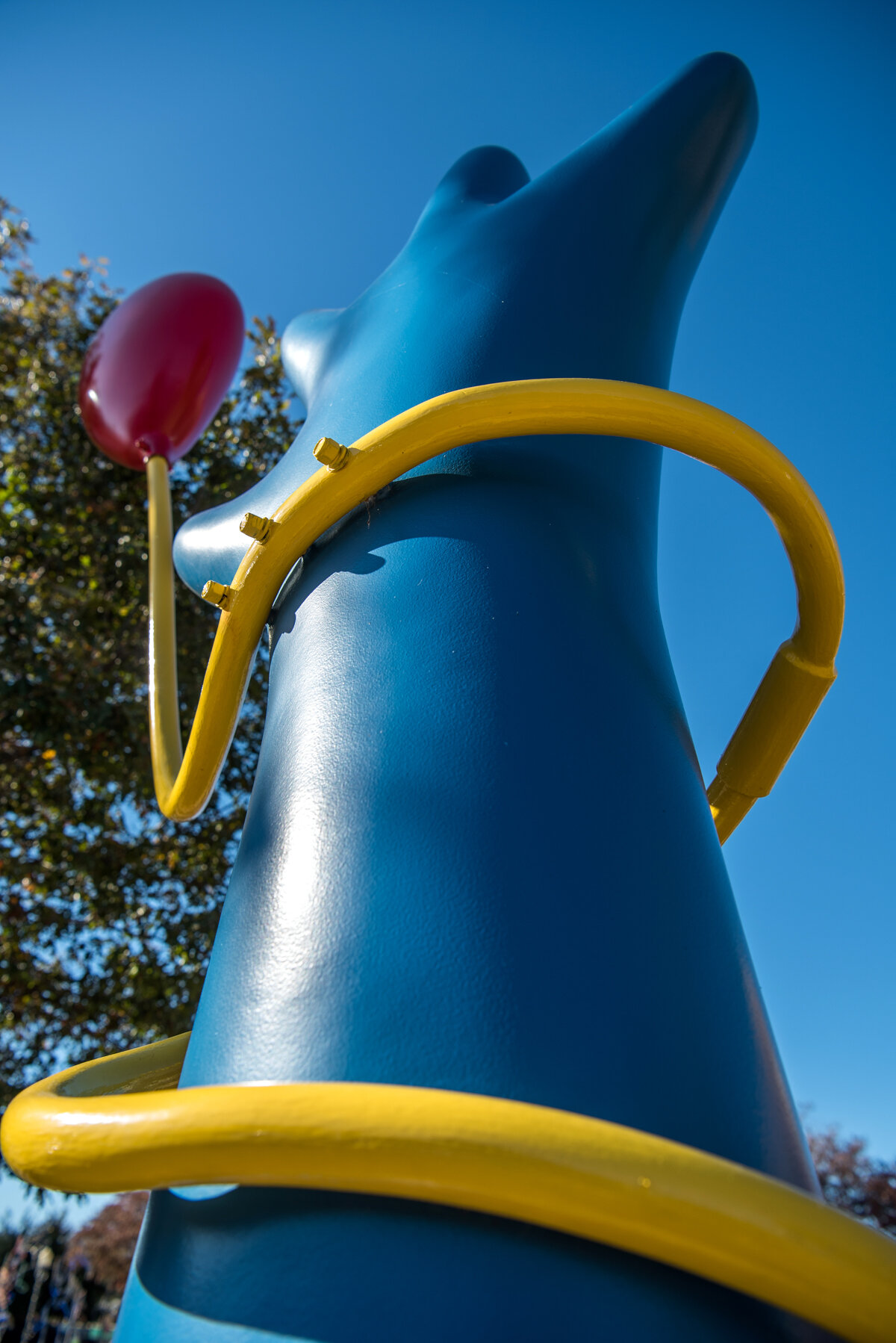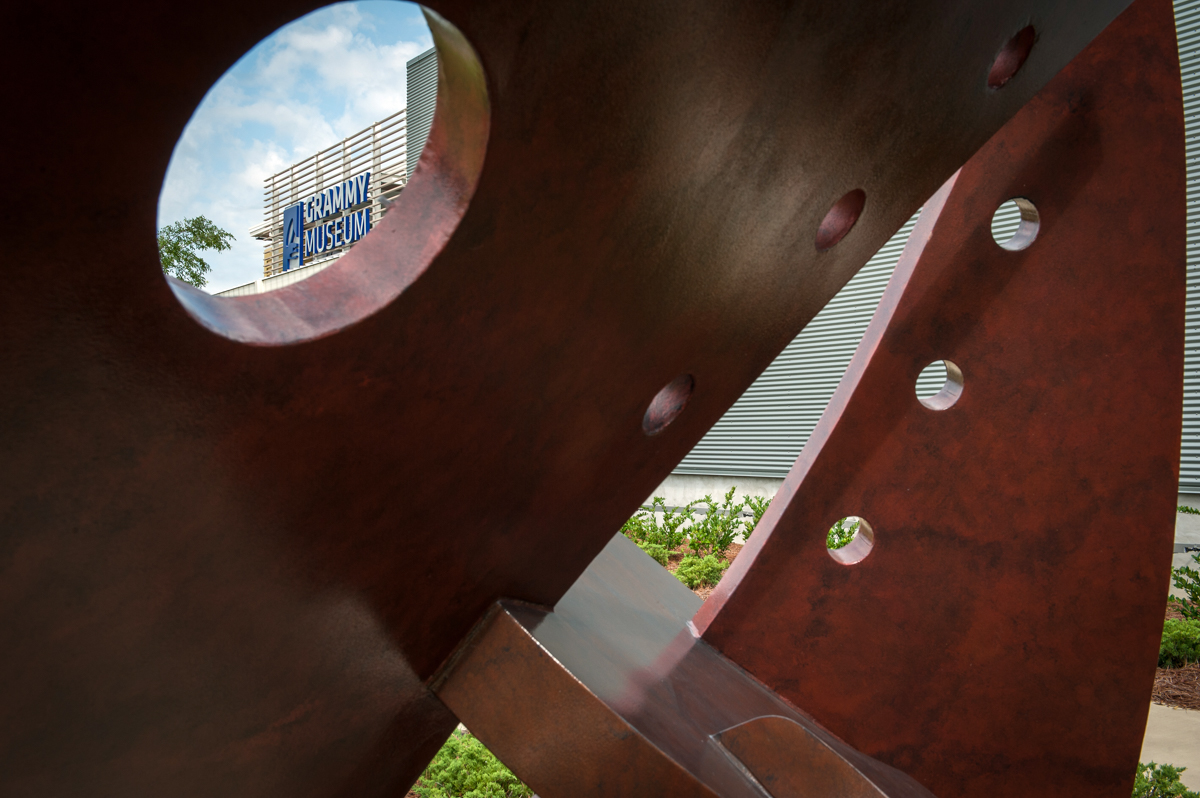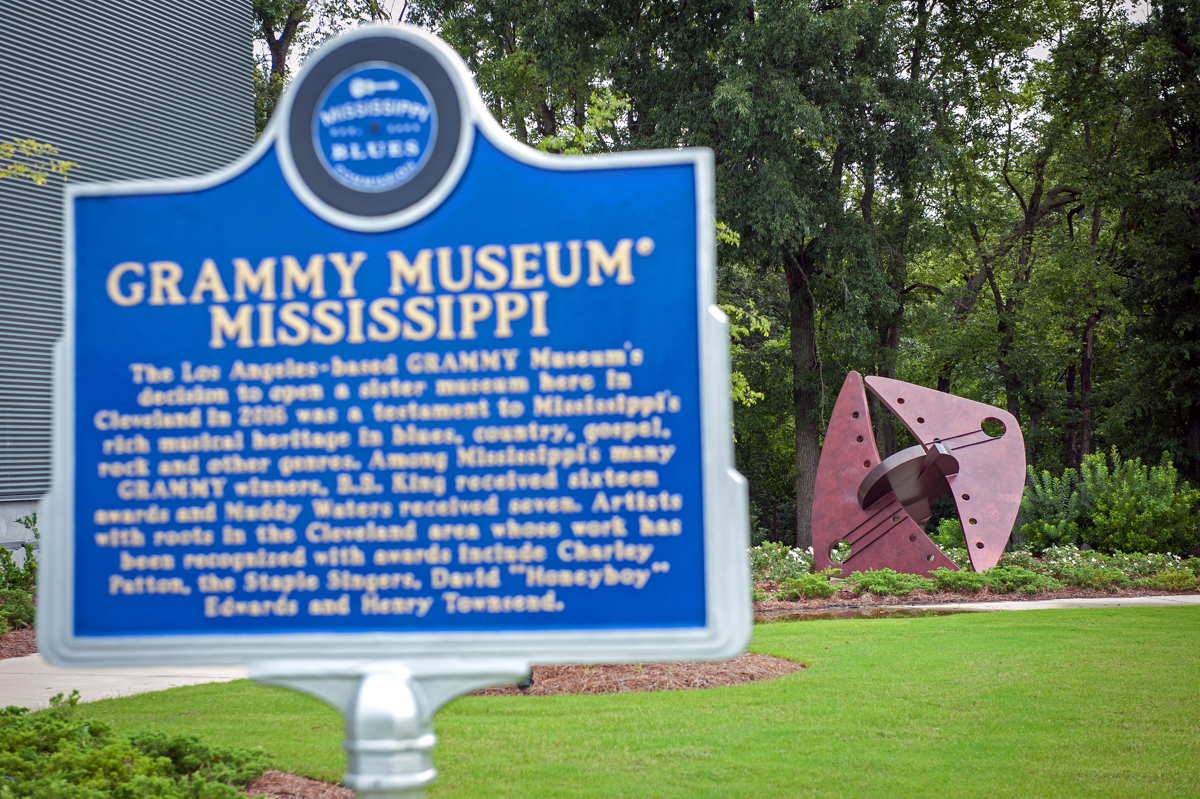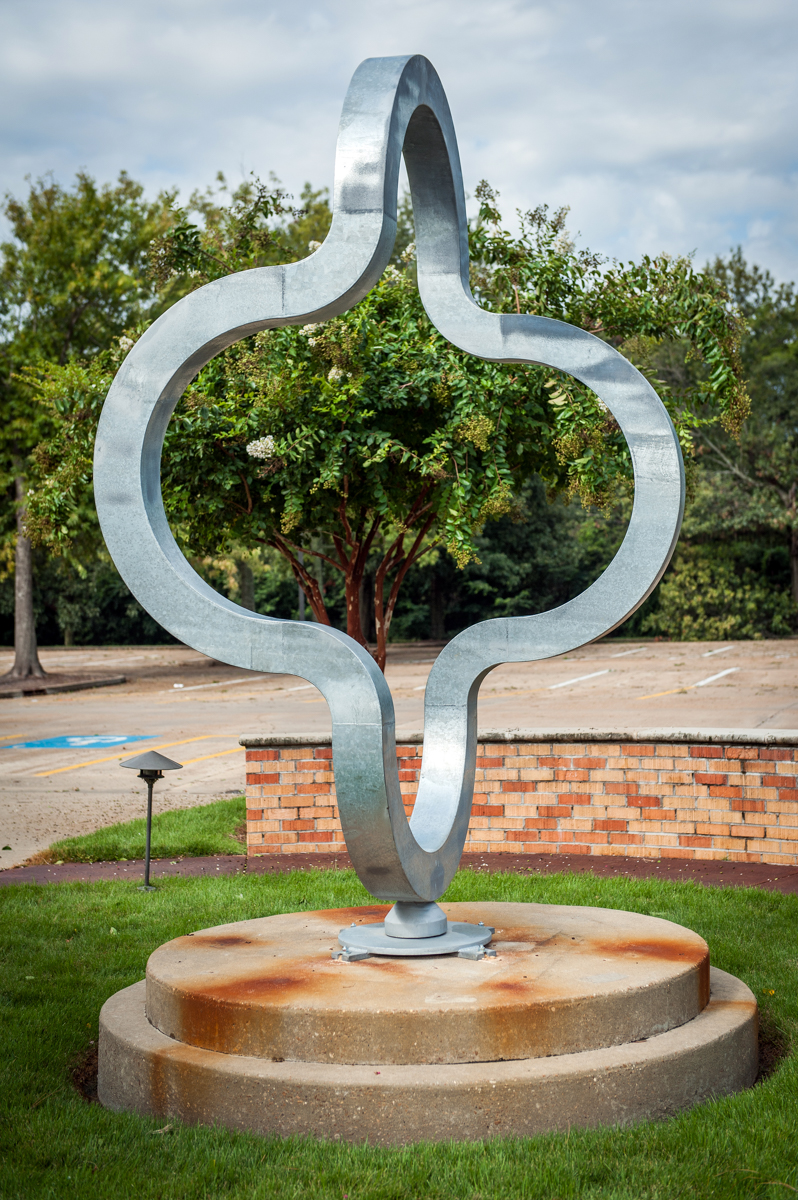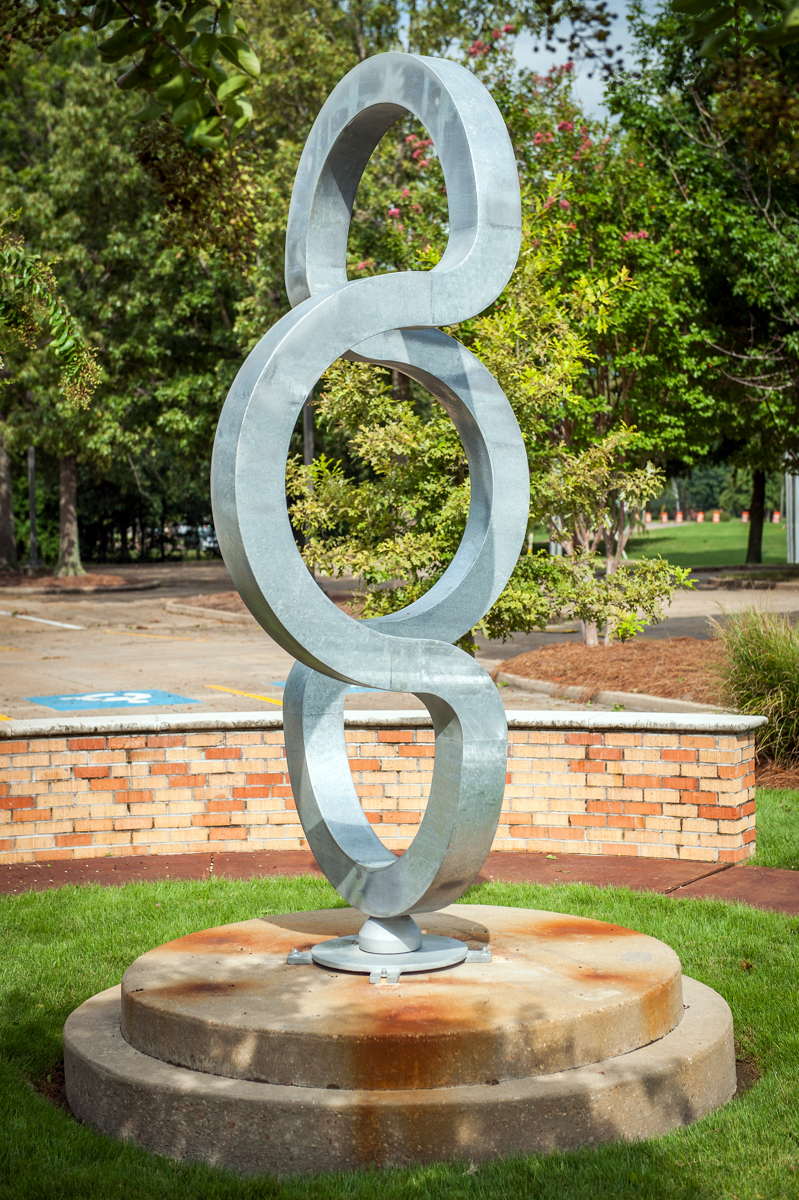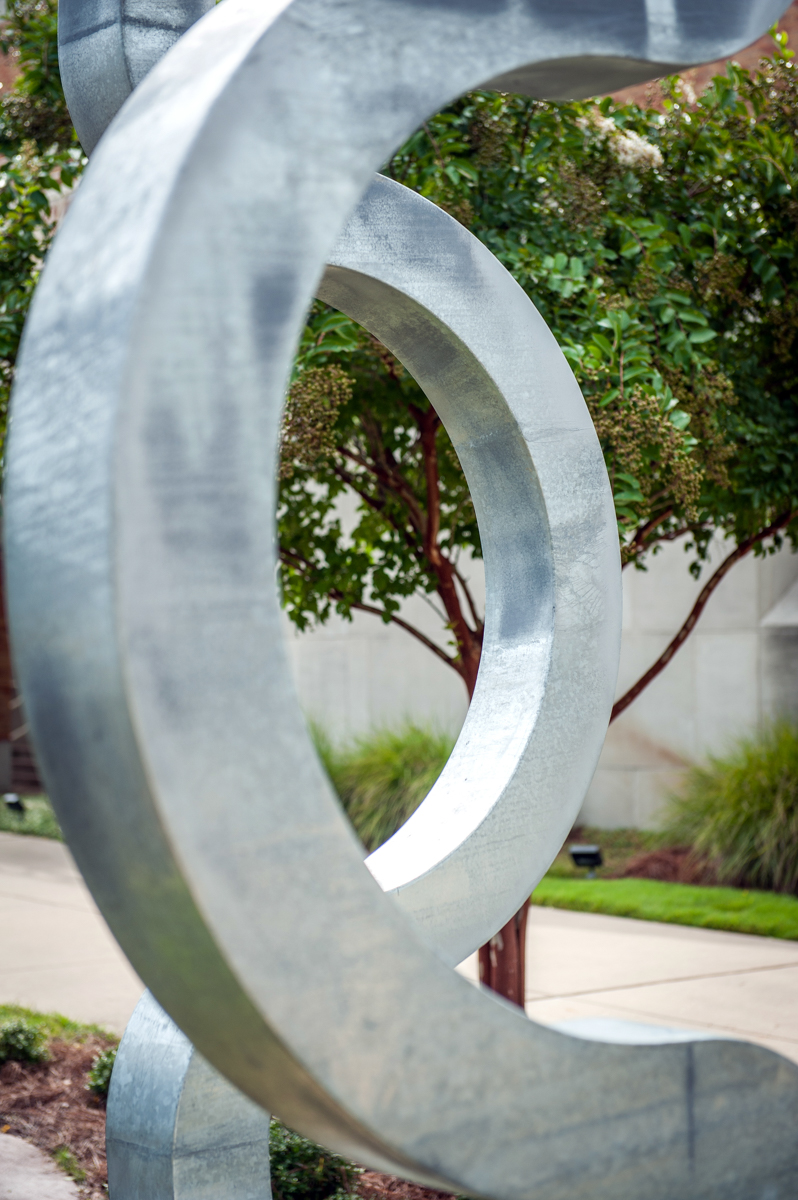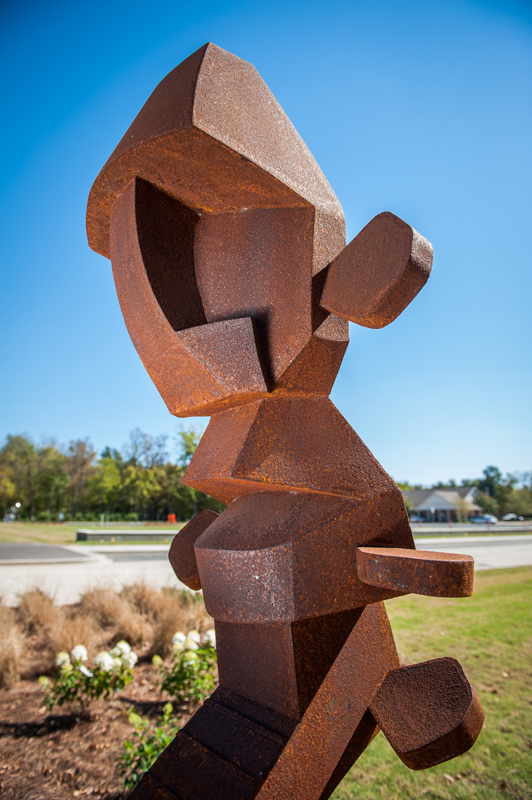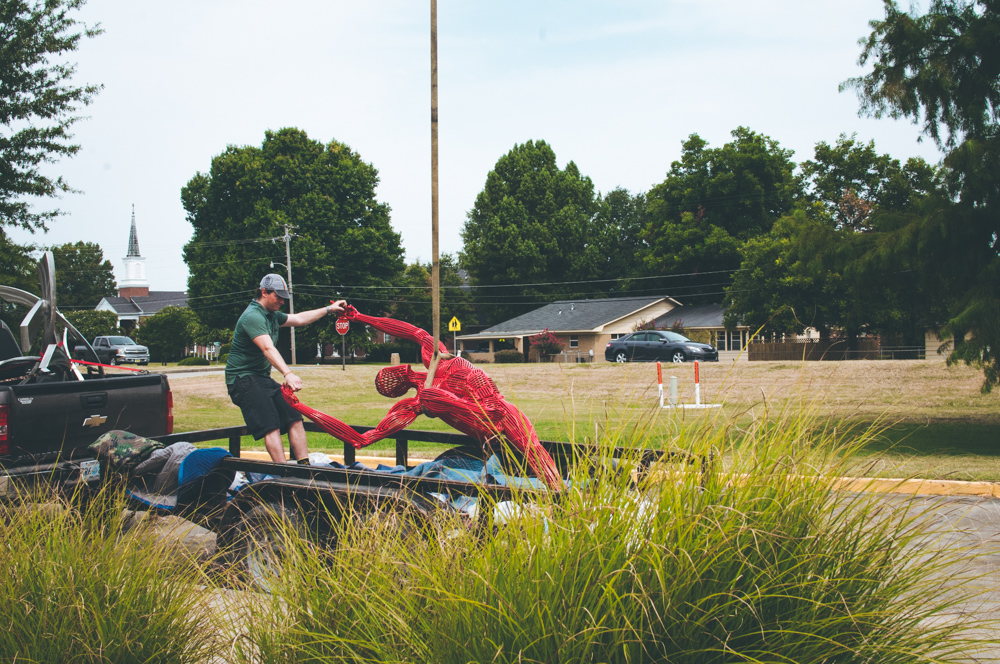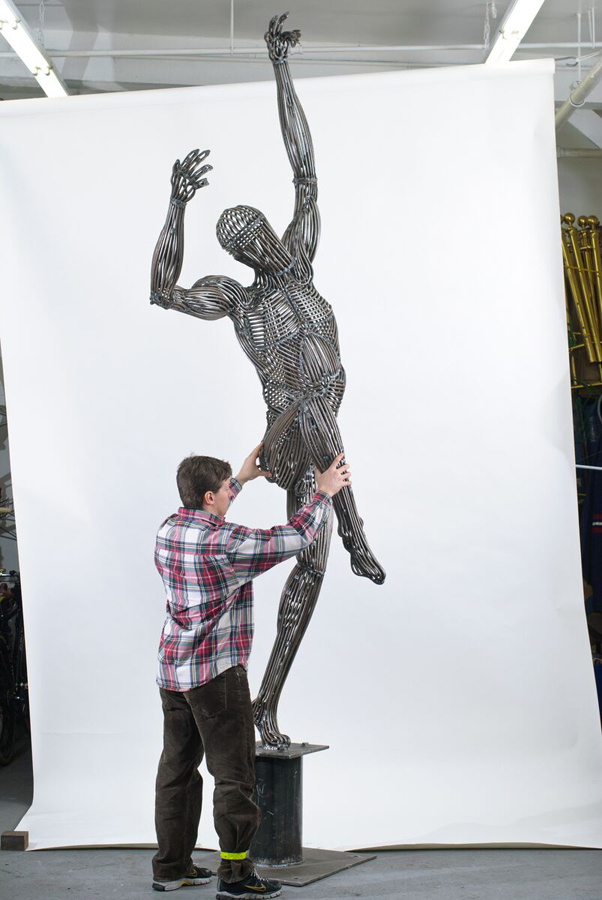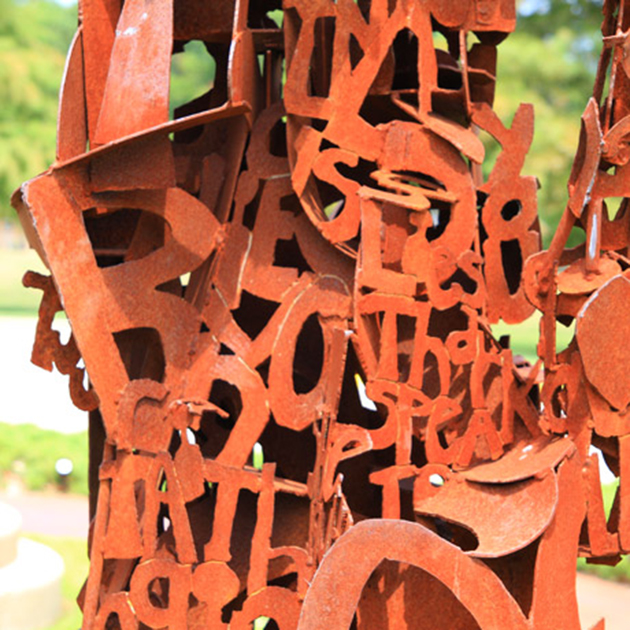Returning for his second consecutive competition class, Mississippi Delta native and Delta State University graduate, Lawson King has been apprenticing for public art veteran and venerable sculpture rock star, Ray Katz – also a fellow exhibitor, this year. “Ray and I met at the previous installation here in Cleveland, and it was quick. We were bonded right away; he’s an amazing soul and an inspiration – a true mentor,” King lauds. “My time in Pontiac (Michigan) has taught me so much, I’m learning everyday about my craft, my desires, my vision – everything really.” Those lessons learned are in full display in his newest piece, Hold On/Let Go. Challenging himself more than he has with any other piece, this 12 foot, fiberglass and steel tubing construct offered King fertile ground to survey his newest thematic exploration – control. “I think the balloon in the piece is metaphoric; it represents our desire to hold on, to think we are in control; but a balloon can slip out of our hands quickly. So is it better to surrender control, to let go?”
Fermata by Wayne Vaughn
FERMATA, WAYNE VAUGHN
The GRAMMY® Museum Mississippi
As defined in its musical context, a fermata is a pause of unspecified length on a note or rest. As defined by the sculpture of the same name, Wayne Vaughn explains, “My sister passed away while I was working on this piece and it ended up taking on a whole new meaning and significance. Just like in a musical composition, you have pauses in life, and in this case, it was a death in our family we had to overcome. We paused and grieved, and then we moved on; and in the business of getting on, this piece was created.” A classically trained musician and founding member of the over 30-year-old Triangle Brass Band, Vaughn is thrilled to have a piece of his work placed at the GRAMMY® Museum Mississippi, even joking, “I text all my music buddies and told them I made it at the GRAMMY® Museum before they did.”
The Arrangement of Three Circles by Ben Pierce
THE ARRANGEMENT OF THREE CIRCLES, BEN PIERCE
The Mathews-Sanders Sculpture Garden
With the inclusion of The Arrangement of Three Circles into this year’s Competition Class, The Mathews-Sanders Sculpture Garden welcomes its first-ever kinetic sculpture to Delta State University’s campus. The sculpture is named quite accurately, as Missouri-based sculptor, Ben Pierce explains, “It is, literally, three circles cut up and rearranged, but in the process, reinvented as a shape that doesn’t read like a circle.” As for the kinetic aspect, Pierce continues, “I have always believed public art should be interactive, whether that means how you walk through, touch it, knock on it to see what it is made of…Kinetic art allows you to take that to the next level. You can push the piece, stand on the piece, ride the piece. It allows you to shift your perspective and see the piece from so many more angles. I love that challenge.”
Blues Man by Michael Stanley
Tribute to Stradivarius by Bryan Massey
Man With A Guitar by Mark Dickson
Generational Slaps by Matt Miller
Dancer 10 by Jack Howard-Potter
Artist’s Statement
I work to capture movement in a medium that does not move. Using steel, which is an inherently rigid material, I work to convey a sense of fluid action in space. My work explores the wide range of movement of the human figure informed through my study of drawing the human anatomy. My sculptures seek to convey the motion of the body in extremely stressful and beautiful positions; the moment that a dancer is at the peak of a jump, the weightless split second before a body succumbs to gravity. I am describing an ephemeral action in steel to convey this moment for eternity. I want the viewer to visualize the actions that led up to a given pose and the actions that will follow it. Using the brightly colored surfaces separates the figures from the landscape, making them stand out in much the same way people do when they wear clothes. The brilliant colors serve as protection for the steel from the corrosive outdoor environment as well as adding excitement to the steel to aid in the sense of movement. The work explores the range of possibilities and flexibility of the material as well as the subject matter.
Artist Biography
Motivated by his study of human anatomy and movement, Jack Howard-Potter works with steel to create large-scale figurative sculptures. His work has been on display throughout the world in outdoor sculpture parks, galleries and public art exhibitions.
Howard-Potter grew up in New York City where he was inspired by the public sculpture of Alexander Calder, George Ricky and various performance, dance, and artistic exposure. He earned a BA in Art History and Sculpture from Union College and has been making and displaying his original sculpture since 1997.
After college, Howard-Potter moved to Colorado and worked with a blacksmith creating furniture and learning about the properties of steel, the medium that he would eventually use to create his art. Howard-Potter also gained the skills to convey a heightened sense of fluidity in solid steel while learning about the commercial practices of metalworking
In 2001 Jack enrolled in anatomy and drawing classes at the Art Students League in New York City to further his skills as a figurative artist and understand how the human form works and moves. Famed artist and instructor at the League for 40 years, Anthony Palumbo, selected Howard-Potter to work as his assistant and eventually became his mentor. For two years Jack immersed himself in the human form, sketching five days each week and completing thousands of drawings. It was this practice that gave him the in-depth knowledge of human anatomy that can be seen in his work today.
In 2005 Howard-Potter made his largest and most daring sculpture to date, The Muse. Standing 27 feet tall the monumental figure of a female form taking to the sky, made out of almost two thousand pounds of steel covered in a galvanized and powder coated silver skin took 4 months to complete and representing a major success in Mr. Howard-Potter’s career.
Jack has permanent and long-term displays in sculpture parks, municipalities and galleries across the country including Marco Island and Coral Springs, Florida; San Antonio, Texas; Pemberton, New Jersey; Salem, New York; Jackson, Tennessee; Glenwood Springs, Colorado; Chicago, Illinois and Blaine, Washington.
Howard-Potter resides in New York City with his wife, Erica, daughter, Skylar and son Lyndon, and is a member of the board of trustees for the Elisa Monte Dance Company where he continues sketch rehearsals and draw inspiration from the dancers.
Gesture by Cliff Tresner
PIECE SPECIFICATIONS:
Corten Steel, 10’H x 3’W x 3’D
CREATION DATE:
2011
click photos to enlarge
HOMETOWN:
Indiana
STUDIO LOCATION:
Monroe, LA
HOW LONG HAVE YOU BEEN SCULPTING?
BFA in Sculpture 1990, Indiana State University; MFA, 1994 from University of Mississippi
WHAT GOT YOU INTO THIS MEDIUM?
Steel is a great material that allows me to work by adding material through welding, or removing material through cutting. It is much like drawing in this respect, drawing a line or adding and erasing a line.
WHERE DID THE INSPIRATION FOR THIS SELECTED PIECE DERIVE?
I began using words in art to work through formal writing issues, primarily in drawing. In 2007, the words became part of my sculptural concerns.
TELL US ABOUT THE CHALLENGES ASSOCIATED WITH CRAFTING THIS PIECE.
Hard and hot work in the very long Louisiana summers. Working large inside does not always translate into looking large outside. While making the work, it feels really big. When placed outside, it loses this perspective. This becomes a challenge, to make it intimate enough for one to approach and engage in the work on a personal level.
HOW LONG DID IT TAKE YOU TO COMPLETE THIS PIECE?
Approximately four months.
HOW DO YOU WANT THE SCULPTURE GARDEN AUDIENCE TO LOOK AT YOUR WORK?
With curiosity and questioning. It is not about what I am trying to say or do, it is about what the viewer takes away from the work, or gives to the work through discussion.
WHAT OTHER ARTISTS INSPIRE YOU?
I was first inspired by Da Vinci. Since, I have gained inspiration from many artists - Duchamp, Rodin, Brancusi, and most recently Anthony Gromely.
Rising Sun by Hanna Jubran
PIECE SPECIFICATIONS:
Stainless Steel & Bronze, 8' × 18' × 14'
CREATION DATE:
2008
click photos to enlarge
HOMETOWN:
Grimesland, North Carolina
STUDIO LOCATION:
Grimesland, North Carolina
HOW LONG HAVE YOU BEEN SCULPTING?
30 years
WHAT GOT YOU INTO THIS MEDIUM?
Interest in the arts
WHERE DID THE INSPIRATION FOR THIS SELECTED PIECE DERIVE?
From nature, the rising sun, the horizon, day and night and the cycle of life.
TELL US ABOUT THE CHALLENGES ASSOCIATED WITH CRAFTING THIS PIECE.
I don't consider creating my sculpture as a challenge but as an expression.
HOW LONG DID IT TAKE YOU TO COMPLETE THIS PIECE?
One year
HOW DO YOU WANT THE SCULPTURE GARDEN AUDIENCE TO LOOK AT YOUR WORK?
Since it is abstract and combined materials I want the viewer to enjoy the texture, surface play of light, the form and a significant meaning they see in it.
WHAT WOULD YOU HOPE THE AUDIENCE TAKES AWAY FROM YOUR PIECE?
Refer to statement below.
WHAT OTHER ARTISTS INSPIRE YOU?
Many-but I have achieved my own style.
WHY DO YOU DO THE WORK YOU DO?
It is my profession.
WHERE DO YOU HAVE OTHER WORKS?
Refer to statement.
HOW DO YOU FINANCE THE WORK THAT YOU DO?
Selling my work.
I have been a participant of a great number of outdoor exhibitions and several International symposiums. My most recent accomplishments have included the participation in the following places, Art in the City Plaza in Raleigh, Cary outdoor Sculpture, Kingsport Tennessee, Lakeland Florida and several more. Most recent symposiums: Hojer Denmark, Granby Canada, Breckenridge Colorado, St. Blasien Germany, Tultepec Mexico all of which were International woodcarving or welded steel symposiums. All of the symposiums were a success, in that I placed high in the competitions as a representative of North Carolina.
My Goals.
(1) To continue exhibiting and participating in symposiums and conferences on national and international level.(2) To make the public aware of the new exhibitions and to stimulate interest in public art and local schools.(3) The maintenance of high quality work and craftsmanship.(4) A commitment to national and local exhibitions. Providing lectures and workshops in academic and professional fields.(5) Promoting public art.(6) The continued development of my research and creative work.
Artist Statement
If a goal is sought either consciously or unconsciously in the form of a work of art, one must solve innumerable problems and make innumerable decisions in order to achieve that end. One of many decisions I have made is maintaining and preserving the natural quality of the materials I work with. My work addresses the concept of time, movement, balance and space. Each sculpture occupies and creates its own reality influenced by its immediate surroundings.
The need for support is one of timing and time. I feel the work is ready for major exhibition. My future concern is to be able to continue my professional career as an educator and sculptor. Participating in this exhibition would open a new door for my future, as I would become more active in creating a sizeable body of work to show regionally, nationally and internationally.
Lonesome Old River by Gary Mitchell
PIECE SPECIFICATIONS:
Formed Aluminum, 72"
click photos to enlarge
HOMETOWN:
St. Louis, Missouri
HOW LONG HAVE YOU BEEN SCULPTING?
30-plus years.
WHAT GOT YOU INTO THIS MEDIUM?
An exposure to the aircraft industry.
WHERE DID THE INSPIRATION FOR THIS SELECTED PIECE DERIVE?
A Greek statue of Ariadne.
TELL US ABOUT THE CHALLENGES ASSOCIATED WITH CRAFTING THIS PIECE.
Translating antique shapes into modern industrial methods.
HOW LONG DID IT TAKE YOU TO COMPLETE THIS PIECE?
About two months.
HOW DO YOU WANT THE SCULPTURE GARDEN AUDIENCE TO LOOK AT YOUR WORK?
As a construction like an airplane fuselage.
WHAT WOULD YOU HOPE THE AUDIENCE TAKES AWAY FROM YOUR PIECE?
A sense that it is good to have bodies.
WHAT OTHER ARTISTS INSPIRE YOU?
Elie Nadleman, William Zorach, Malloil
WHY DO YOU DO THE WORK YOU DO?
Because it is one of the only things I do well.
WHERE DO YOU HAVE OTHER WORKS?
Hot Springs, Arkansas; Wildwood, Missouri; Lafayette, Colorado
HOW DO YOU FINANCE THE WORK THAT YOU DO?
Gifts from patrons, 70 percent; Sales, 30 percent.
Roots Revisited by Glenn Zweygardt
PIECE SPECIFICATIONS:
Steel, Stainless Steel, Cast Iron, Bronze, Ductile Iron, 106" × 83" × 32"
CREATION DATE:
2010
click photos to enlarge
HOMETOWN:
Alfred Station, New York
FROM THE ARTIST:
"To see that which is not normally seen," is the underlying theme of ROOTS REMEMBERED. I collected roots for approximately five years. I then made ceramic molds of the roots, burned out the organic matter and finally cast the voids with various metals.I love the power of circles; they are so eternal and strong. Try to find Venus and small guardians in the roots. Some of the roots are from an original Zweygardt timber claim in Kansas, thus a rediscovery of my ancestral roots."
The works of Glenn Zweygardt are simultaneously ancient and contemporary. With his use of diverse materials - cast bronze, glass, iron, marble, stainless steel, stone and granite - he creates complex media sculptures that exemplify a master of the three dimensional form.
Zweygardt possesses an uncanny ability to fuse dissimilar elements and concepts, natural occurring and fabricated forms, into structures that command the attention if the observer. This interaction of artist, nature and technology has a unifying affect on the observer's imagery and psyche.
Duplication and relationship is a recurring theme found throughout Zweygardt's work. A carefully chosen stone, cast and duplicated in bronze, aluminum or steel becomes the basis of definite architectural themes that manifest in a range of sizes. Zweygardt's mastery of the building process along with his ability to create enormous works of art from materials of tremendous mass has gained him international recognition and membership to the Berman Group, a cooperative of sculptors whose collective work spans virtually the entire spectrum of possibilities of "traditional" modernist sculpture.
Kansas born, Zweygardt earned the BFA degree from Wichita State in 1967. He received the MFA from the Maryland Institute of Art in 1969 and is an emeritus Professor of Sculpture at the New York State College of Ceramics at Alfred University. Zweygardt works independently in his immense workshop in Alfred Station, New York. Here his work continues to evolve-varied shapes and rich surfaces, transparent and dense forms, concept and technical relationships, personal and collective perceptions-into fine art of eminent legacy.
Haiku Man by Glenn Zweygardt
PIECE SPECIFICATIONS:
Cast Bronze, Cast Glass, Stone, 120" × 44" × 21"
EXHIBITION CLASS II, 2002-2004, Purchase Award Winner
Located in Sculpture Garden, Front Lawn of Bologna Performing Arts Center
click photos to enlarge
HOMETOWN:
Alfred Station, New York
FROM THE ARTIST:
"Finding ones place in a relationship with nature is the theme of my sculpture. While working with materials such as metal and stone, a relationship between nature and myself is formed. Further, I want to tell stories and comment on my collective life experience and my perception of a collective consciousness? Hopefully, these ideas and expressions will enter into human consciousness and the fourth dimension."
The works of Glenn Zweygardt are simultaneously ancient and contemporary. With his use of diverse materials - cast bronze, glass, iron, marble, stainless steel, stone and granite - he creates complex media sculptures that exemplify a master of the three dimensional form. Zweygardt possesses an uncanny ability to fuse dissimilar elements and concepts, natural occurring and fabricated forms, into structures that command the attention if the observer. This interaction of artist, nature and technology has a unifying affect on the observer's imagery and psyche.
Duplication and relationship is a recurring theme found throughout Zweygardt's work. A carefully chosen stone, cast and duplicated in bronze, aluminum or steel becomes the basis of definite architectural themes that manifest in a range of sizes. Zweygardt's mastery of the building process along with his ability to create enormous works of art from materials of tremendous mass has gained him international recognition and membership to the Berman Group, a cooperative of sculptors whose collective work spans virtually the entire spectrum of possibilities of "traditional" modernist sculpture.
Kansas born, Zweygardt earned the BFA degree from Wichita State in 1967. He received the MFA from the Maryland Institute of Art in 1969 and is an emeritus Professor of Sculpture at the New York State College of Ceramics at Alfred University. Zweygardt works independently in his immense workshop in Alfred Station, New York. Here his work continues to evolve-varied shapes and rich surfaces, transparent and dense forms, concept and technical relationships, personal and collective perceptions-into fine art of eminent legacy.
Wedge by Skip Van Houten
PIECE SPECIFICATIONS:
Steel, 95" × 45" × 21"
click photos to enlarge
HOMETOWN:
Hattiesburg, Mississippi
FROM THE ARTIST:
"I have always believed that public sculpture should be both lyrical and serious. Ideally, it should offer hope and provide something for the viewer's imagination to play with. Art for me has to be fun. I feel that "Wind Harp" is an aesthetically pleasing form to admire yet it also represents a musical instrument. Although it makes no sound, one can imagine the tunes that could be played on it."
Zig Zag by Stephen Janesko
PIECE SPECIFICATIONS:
Stainless Steel, Steel 7' × 17" × 17"
click photos to enlarge
HOMETOWN:
Tonganoxie, Kansas
Homage to Growth by Glenn Zweygardt
PIECE SPECIFICATIONS:
Granite, Marble, Cast Bronze, Powder Coated, Steel, 168" × 36" × 22"
click photos to enlarge
HOMETOWN:
Alfred Station, New York
FROM THE ARTIST:
"From my early childhood spent on a Kansas farm, I have been watching plants and animals grow. It is critical that one "pays attention" to both plants and animals to have a prospering farm. Living as an adult in upstate New York in a heavily forested part of the state, I found foliage growth to be an overwhelming experience and influence on my work."
The works of Glenn Zweygardt are simultaneously ancient and contemporary. With his use of diverse materials - cast bronze, glass, iron, marble, stainless steel, stone and granite - he creates complex media sculptures that exemplify a master of the three dimensional form. Zweygardt possesses an uncanny ability to fuse dissimilar elements and concepts, natural occurring and fabricated forms, into structures that command the attention if the observer. This interaction of artist, nature and technology has a unifying affect on the observer's imagery and psyche.
Duplication and relationship is a recurring theme found throughout Zweygardt's work. A carefully chosen stone, cast and duplicated in bronze, aluminum or steel becomes the basis of definite architectural themes that manifest in a range of sizes. Zweygardt's mastery of the building process along with his ability to create enormous works of art from materials of tremendous mass has gained him international recognition and membership to the Berman Group, a cooperative of sculptors whose collective work spans virtually the entire spectrum of possibilities of "traditional" modernist sculpture.
Kansas born, Zweygardt earned the BFA degree from Wichita State in 1967. He received the MFA from the Maryland Institute of Art in 1969 and is an emeritus Professor of Sculpture at the New York State College of Ceramics at Alfred University. Zweygardt works independently in his immense workshop in Alfred Station, New York. Here his work continues to evolve-varied shapes and rich surfaces, transparent and dense forms, concept and technical relationships, personal and collective perceptions-into fine art of eminent legacy.
Stone Clone X by Glenn Zweygardt
PIECE SPECIFICATIONS:
Stone, Cast Iron, Stainless Steel, 124" × 62" × 28"
CREATION DATE:
2010
click photos to enlarge
HOMETOWN:
Alfred Station, New York
FROM THE ARTIST:
"Science is great; mankind rises and falls from ideas and thoughts, the perceptions of a civilization. When scientists cloned Dolly the sheep, I felt impelled to "clone" a stone, thus, the iron casting of a stone. Be sure to walk around the piece and compare the cloned elements. Finding ones place in a relationship with nature is the theme of my sculpture. While working with materials such as metal and stone, a relationship between nature and myself is formed. Further, I want to tell stories and comment on my collective life experience and my perception of a collective consciousness? Hopefully, these ideas and expressions will enter into human consciousness and the fourth dimension."
The works of Glenn Zweygardt are simultaneously ancient and contemporary. With his use of diverse materials - cast bronze, glass, iron, marble, stainless steel, stone and granite - he creates complex media sculptures that exemplify a master of the three dimensional form. Zweygardt possesses an uncanny ability to fuse dissimilar elements and concepts, natural occurring and fabricated forms, into structures that command the attention if the observer. This interaction of artist, nature and technology has a unifying affect on the observer's imagery and psyche.
Duplication and relationship is a recurring theme found throughout Zweygardt's work. A carefully chosen stone, cast and duplicated in bronze, aluminum or steel becomes the basis of definite architectural themes that manifest in a range of sizes. Zweygardt's mastery of the building process along with his ability to create enormous works of art from materials of tremendous mass has gained him international recognition and membership to the Berman Group, a cooperative of sculptors whose collective work spans virtually the entire spectrum of possibilities of "traditional" modernist sculpture.
Kansas born, Zweygardt earned the BFA degree from Wichita State in 1967. He received the MFA from the Maryland Institute of Art in 1969 and is an emeritus Professor of Sculpture at the New York State College of Ceramics at Alfred University. Zweygardt works independently in his immense workshop in Alfred Station, New York. Here his work continues to evolve-varied shapes and rich surfaces, transparent and dense forms, concept and technical relationships, personal and collective perceptions-into fine art of eminent legacy.
Triolisk by Dan Johnson
PIECE SPECIFICATIONS:
Earth Cast Colored Concrete, 12’ × 1’ × 1’
click photos to enlarge
HOMETOWN:
Alto Pass, Illinois
FROM THE ARTIST:
"Like an obelisk but with just three sides, this colored concrete piece reaches for the heavens. The work started in the soil though, it was cast in the earth. Using the traditions of totem poles and the skyward reach of obelisks and steeples, I’ve tried to create a piece that both holds interest in the here and now and points towards the endless possibilities we all have."
Torso by Lynn Olson
PIECE SPECIFICATIONS:
Fiber Cement, 42 ½”
HOMETOWN:
Valparaiso, Indiana
FROM THE ARTIST:
“My sculptural work has developed techniques for making portland cement into a direct aesthetic medium. The direct modeling techniques that I have developed free cement sculpture from the limiting and restrictive constrictions of the casting process. These direct techniques now make it possible to build steel reinforced cement designs of any size and of any complexity. Steel wool fibers, carbon fibers and pigments in white cement matrix now make it possible to shape the most intricate surface details. This fiber-cement surface can be tool worked and polished to reveal rich and intriguing grain and color qualities.
My study of cement technology and steel reinforcement has developed procedures for producing durable, weatherproof and permanent outdoor sculptures. I have designed and built several durable, steel reinforced cement matrix sculptures that were commissioned and are now installed in both outdoor and interior locations. Stainless steel reinforcement is now used exclusively in all my cement sculptures.”
Tara Firma by Marie C. T. Lentsch
PIECE SPECIFICATIONS:
Steel, 40" (three spheres)
HOMETOWN:
Waterloo, Iowa
THREE STEEL BALLS, FIVE MISSISSIPPI BOULDERS
An Artist's Statement by Marie Camille Truscott Lentsch
MA THE MEDICINE BALL
This was the first one, female, how is that!?
Gentler, was the smaller one;
The medicine ball, full of wishes, half shiny, half rusty;
Some welds polished, some smooth.
Our eggs are round and there is an internal equator;
Longitudes and latitudes polished off,
Like peeling an orange apart, the segments go together.
When complete, I rolled it everywhere — across campus, up stairs and down, put it in my truck for a drive. It became an entity. I know it sounds silly to do that, but I did. It looked regal on some brick walls. But closer to the earth was best for this ball. Then after awhile, I got an urge to do two . . .
SUN BALL
The second steel ball;
Easier to form, firmer with convictions ping.
Ting into place, tack welded never a pop. Shiny, a companion bright.
I rolled it around, too. Sealed it so tight, it could actually float on water. Maybe it was left on the shore when the ocean changed its mind. The slag from the weld makes a sound inside, a metally tinkling sound, like those baby toys that tinkle when they roll in a zig zag. The second size was actually easier to weld, the gores went together with less force and weren't so spring loaded as the first ball.
They looked cool hanging out in the shop together, a couple! It was funny and fun to see them. Then...that's right, oh my, yes...a third one.
BAMBINI BALL
. . . was the third. How did the third ball get so big? It was just a baby!
How babies are bigger than all reality when they arrive and though they are tiny and precious; their entry and presence is immense.
Well, that is how it should be. And each generation gets bigger, expands larger and heals wider — forward and backward.
Look what we created!
How to be three was now the new form.
Where would they go and how did they fit? Compassion becomes curious.
Then I saw them amidst some large rocks, nestled in, as you see them now.
Generous memories in Mississippi boulders, solidified compassion that was once sand, from a river shore mingling nearing the ocean. The estuary of evolution — sourced.
Someone there found them for me, to complete this piece. That was nice, who was that, there are five of them and they did appear for Tara Firma to be placed amongst. Thank you to whoever did that!
TARA is the Tibetan Goddess of Compassion and Wisdom. TERRA FIRMA is solid Earth. TARA FIRMA is the family of solid compassion on Earth; set firm and tucked in with some other gifts of the Earth. Shiny bright, modern made, in complimentary contrast to solid stone of an earth from another time remembered, both together, like family, isn't it?

